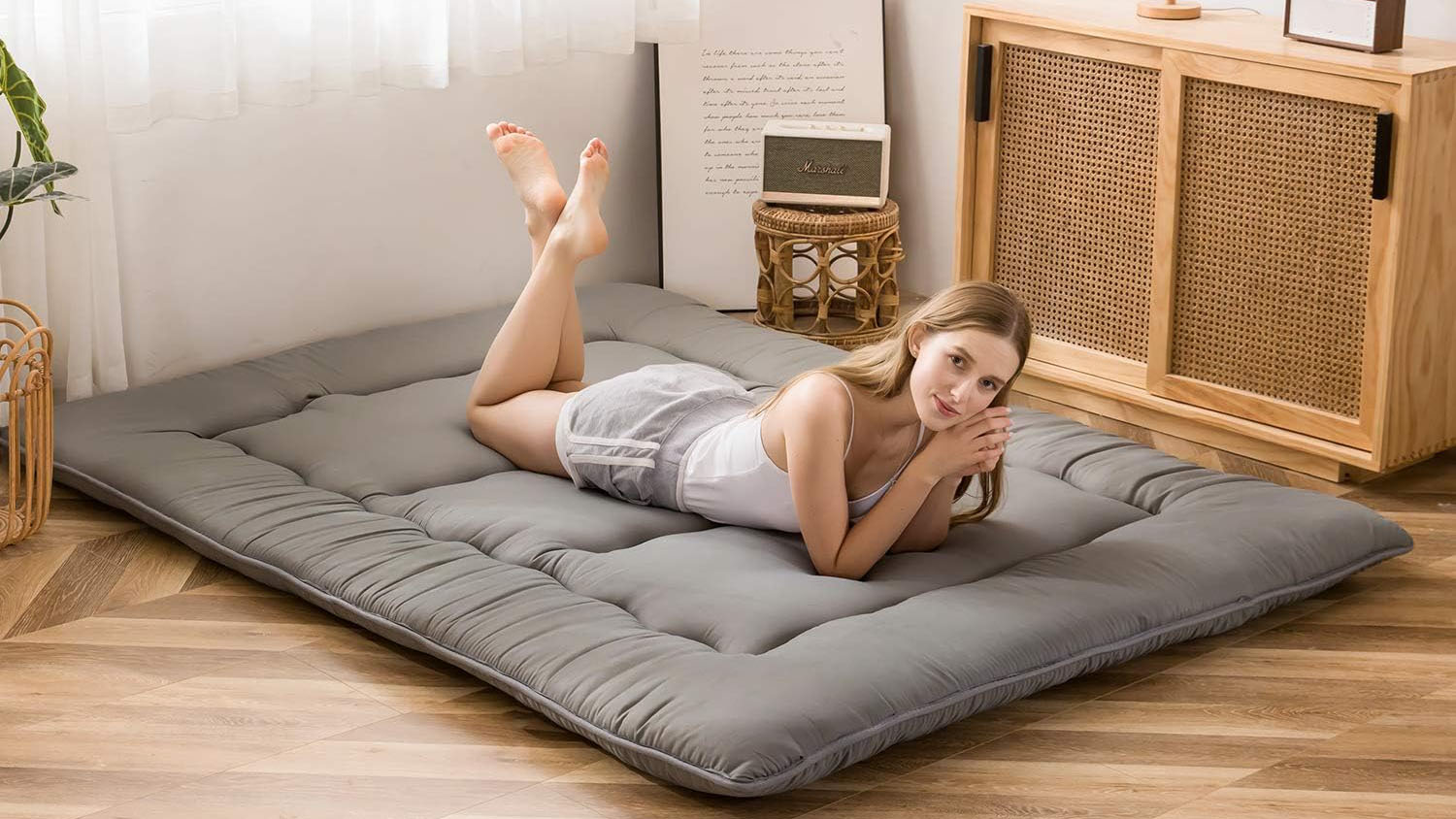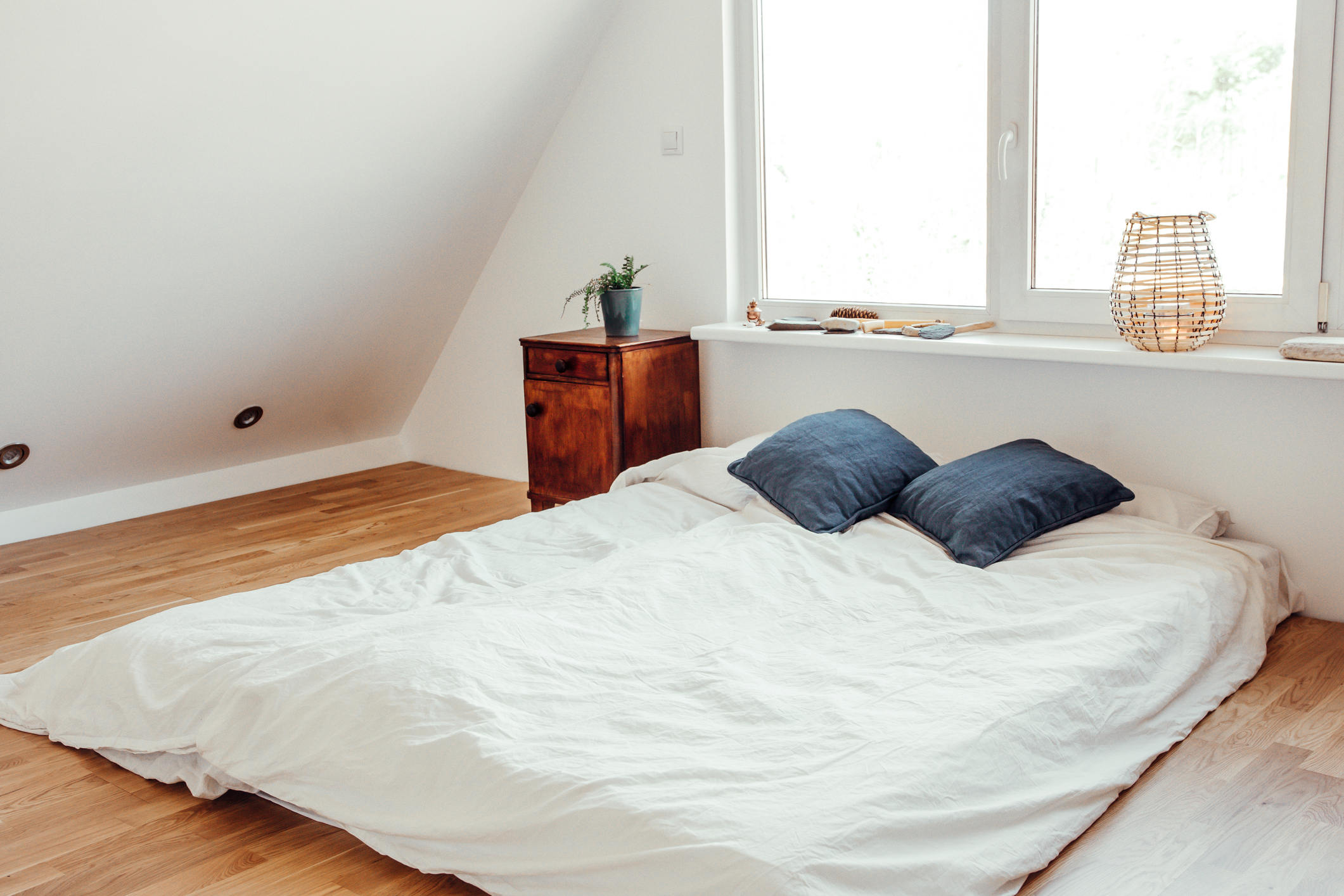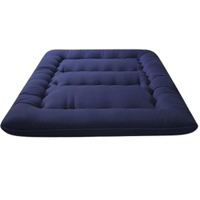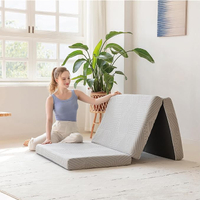What are floor mattresses — and is sleeping on the floor healthy?
Floor mattresses are ideal for unexpected guests and travel, but are they any good for your sleep?

A lot of standard mattresses made today are robust enough to be placed directly on the floor, but that doesn't mean that it's a good idea. For starters, putting your bed directly on the floor can damage it — especially if it’s made from memory foam — and you may be voiding its warranty if the terms state that the mattress must be paired with a bed frame.
However, there are some mattresses out there that are designed to be used directly on flooring. Floor mattresses come in all shapes, sizes, and materials, and are some of the best mattresses for overnight visitors or other short term sleep solutions. They’re also compact, making them great travel companions, plus some can even transform into a chair or sofa for daytime use.
Floor mattresses can be versatile, travel-friendly, and handy when accommodating unexpected guests, but are they healthy to sleep on? Here, we’ll explore the different types of floor mattress available and weigh up the pros and cons of sleeping on the floor in terms of comfort, practicality, and sleep health.
- Do you really need a mattress or is sleeping on the floor better for you?
- Rollaway bed vs foldable mattress vs Japanese floor mattress: Which is best for your sleep and budget?
What are the different types of floor mattress?
There are many different kinds of floor mattress, with each one suiting different sleepers and purposes. Some can only be used at home, while others are compact enough to be used anywhere — but all are suitable for sleeping on the floor. While floor mattresses come in a variety of designs and materials, there are 4 main types:
Japanese floor mattress (or futon): While most Americans are more familiar with the westernized futon that resembles a sofa bed, a traditional futon mattress or Japanese floor mattress has a thinner, foldable design that can be laid out on flooring. They are rectangular, quilted pads that resemble a slimmer version of a memory foam mattress that can be rolled up when not in use. Recently, I tried Amazon’s best-selling Japanese floor mattress, and found it to be surprisingly comfortable.

Thai kapok folding mattress (or mats): Thai mattresses are one of the best floor mattresses for traveling thanks to their slim, roll-able design. They are suitable for both outdoor and indoor use, and can be used during the day as a yoga or massage mat. They are usually filled with kapok, a fluffy, cotton-like substance that’s mainly used to provide soft cushioning.
Air, blow-up or Inflatable mattresses (or airbeds): While air beds are sometimes conflated with mattresses that have adjustable firmness, the kind we’re talking about are the ones often used for traveling or sleepovers and are used as a more temporary sleeping solution. They are usually made of plastic, and are inflated with air when you need to use them. Some are self-inflating (using a remote control or knob), while others are inflated manually using a pump. They are often used on camping trips.
Tri-fold mattress (or Z bed/mattress): Perfect for those who have a small bedroom or apartment and want to save on space, the tri-fold mattress gets its name from the way it can be folded three times. When unfolded completely, it becomes a thick floor mattress, but when folded completely it becomes a chair or footrest.
Is sleeping on the floor healthy?
If you want to sleep on the floor, we do not recommend using a traditional mattress intended to rest upon a bed frame or base. These beds are not designed for floor use and can quickly become damaged, too firm, or a magnet for mold when sitting directly on the floor — especially memory foam mattresses, which require the added ventilation of a bed frame to stay clean and dry.

Floor mattresses are designed to be placed directly on the floor, provided that it is a temporary sleeping arrangement, as it may not provide adequate support for permanent use.
However, one of the key concerns of of sleeping on floor mattresses is cleanliness. As they’re on the ground, floor mattresses are more exposed to dirt and dust, which can aggravate allergies. Remember to clean both your sleep space and mattress regularly, taking into consideration the care instructions of your chosen floor mattress. Some floor mattresses are machine-washable, while others are hand wash or spot-clean only.
There’s no space for adequate air circulation when a floor mattress is directly on the ground, so it can become a breeding ground for mold and mildew. Make sure to clean and air out the mattress regularly, and if the weather’s fine and you have the outdoor space, exposing your mattress to natural sunlight is en effective way to kill bacteria and prevent moisture build-up. You might also want to consider placing a tatami mat (a type of Japanese straw mat) under your floor mattress for comfort and to keep the mattress dry by absorbing moisture.
Who are floor mattresses good for?
Floor mattresses also tend to be firmer than traditional mattresses. Their naturally firm level of support promote deep sleep by encouraging correct spine alignment, which helps reduces back pain. Firm floor mattresses also improve blood circulation and posture, and relieve muscle aches and stiffness. The firmness of some floor mattresses also mean they are particularly comfortable for back and stomach sleepers as they prevent lower back pain by supporting the hips and preventing them from sinking into the surface, which can cause the spine to dip out of alignment.
Also, if you're a hot sleeper, placing your mattress on hardwood flooring or tiles will mean an overall cooler sleep, but avoid carpets as they can have the opposite effect. Avoid the common mattress on the floor mistakes by regularly cleaning and airing your bed and being careful with the placement.
Who shouldn't sleep on floor mattresses?
On the other hand, their naturally firm support level may not provide enough pressure relief or contouring support for those who sleep on their side or have lighter, petite frames. In these cases, sleeping on a firm floor mattress can lead to aches, pains, and pressure build up along the joints. People with mobility issues should also avoid floor mattresses, as the lack of elevation means that getting up and down onto the floor may cause some discomfort or inaccessibility.
Where can I buy floor mattresses?
There are many places to buy a floor mattress online, with beds from top-rated brands available on Amazon. Here's a round-up of the three best floor mattresses, including futons, tri-fold mattresses, and Thai mats. Although we haven't had the opportunity to try these out in person, they all have overwhelmingly positive reviews. Let's take a look.
MAXYOYO Japanese Floor Mattress: from $95.99 at Amazon
This high-density memory foam futon is available in five sizes including king and cot. It also comes with a microfiber cover to help keep the futon free of dust and allergens. Considering its price and firm rating, this mattress is ideal for those looking for a foldable bed for students, travelers, and guests. However, keep in mind that this futon is spot- clean only and hot sleepers should be aware that memory foam does have a tendency to trap heat.
MLILY Tri-Fold Memory Foam Mattress: From $59.99 $47.41 at Amazon
This tri-fold mattress doubles as a comfy chair when not being used as a sleep surface, so it's perfect for saving space in bedrooms and accommodating overnight visitors. Its surface is breathable thanks to the 100% cotton composition, and is filled with memory foam for a comfy sleep. This bed may cause some hot sleepers to become overheated, however, as memory foam doesn't have enough ventilation when placed directly on the floor. Right now, you can get a small single for over 20% off, but the other sizes (from Twin to King) don't have as generous a discount.
Leewadee Rollable Kapok Thai Mattress: From $119.99 at Amazon
With a moisture-wicking cotton cover and filled with breathable kapok, this lightweight mattress is perfect for travelling and storage space. It's suitable for indoor and outdoor use, so it's great for both road trips and house guests. It comes in a variety of sizes and patterns, but be aware that this mat is hand wash only.
Sign up to get the BEST of Tom's Guide direct to your inbox.
Get instant access to breaking news, the hottest reviews, great deals and helpful tips.

Frances Daniels is a PPA-accredited journalist and Sleep Staff Writer at Tom's Guide with an MA in Magazine Journalism from Cardiff University. Her role includes covering mattress and sleep news and writing sleep product reviews and buyer's guides, including our Best Hybrid Mattress 2025 guide. She is hugely interested in the relationship between good sleep and overall health, interviewing a wide array of mattress and sleep experts to create well-informed articles about important topics such as nutrition, sleep disorders (from sleep apnea to night terrors), lucid dreaming, sleep hygiene, and mattress care. She is also our specialist on mattress toppers — producing mattress topper reviews and taking care of our Best Mattress Toppers 2025 guide — and takes the lead on all content related to fiberglass-free mattresses for a clean, non-toxic sleep. Outside of Tom's Guide, she has written for Ideal Home, Homes & Gardens, and Marie Claire.



